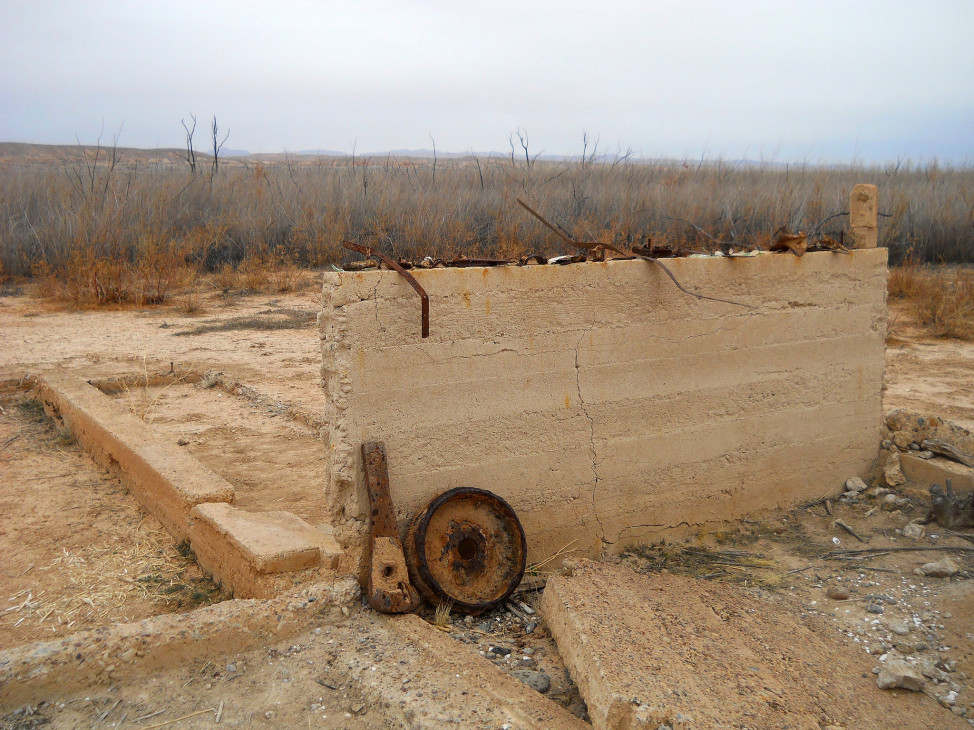
Once submerged under water, the entire town of St. Thomas, Nevada, is now exposed. (Photo: Lake Mead NRA Public Affairs via Flickr)
MORE ABOUT AMERICA
Is America Really 11 Different Countries?
What Happens When Americans Tweet What They Eat
Drought conditions in the Western part of the United States have allowed an old Nevada town once submerged deep beneath Lake Mead to emerge from its watery grave.
Founded in 1865, St. Thomas was initially settled by Mormons drawn by Muddy Creek, a tributary that flows into the Colorado River, located 22 miles away. When the Mormons left in 1871, outlaws — including horse thieves and cattle rustlers — moved in. The town was eventually settled by people attracted by the region’s prime farming land. St. Thomas became a key stopping point between Salt Lake City, Utah and Los Angeles, California.
However, the pioneer town’s fate was sealed in the early 1900s, when the federal government decided to build a dam to harness the power of the Colorado River, thus allowing for westward expansion and large-scale irrigation.
Lake Mead, the reservoir created by the Hoover Dam, became a popular public attraction. Visitors were drawn by the sight of a shimmering body of water set against the harsh backdrop of the arid, unforgiving desert.
But underneath this man-made wonder lay the doomed town of St. Thomas, which had been submerged when the Colorado River began to fill the surrounding canyons and valleys. At its peak, the town’s population reached about 500, and there was a school, church, post office, grocery stores, and an ice cream parlor.
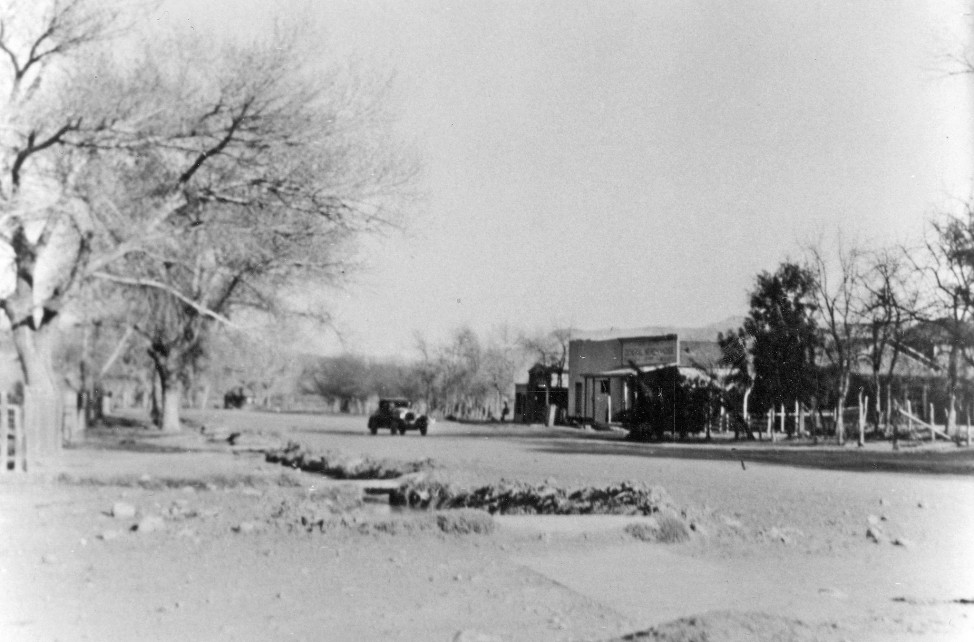
Main Street in St. Thomas, Nevada (Photo courtesy of UNLV via Flickr)
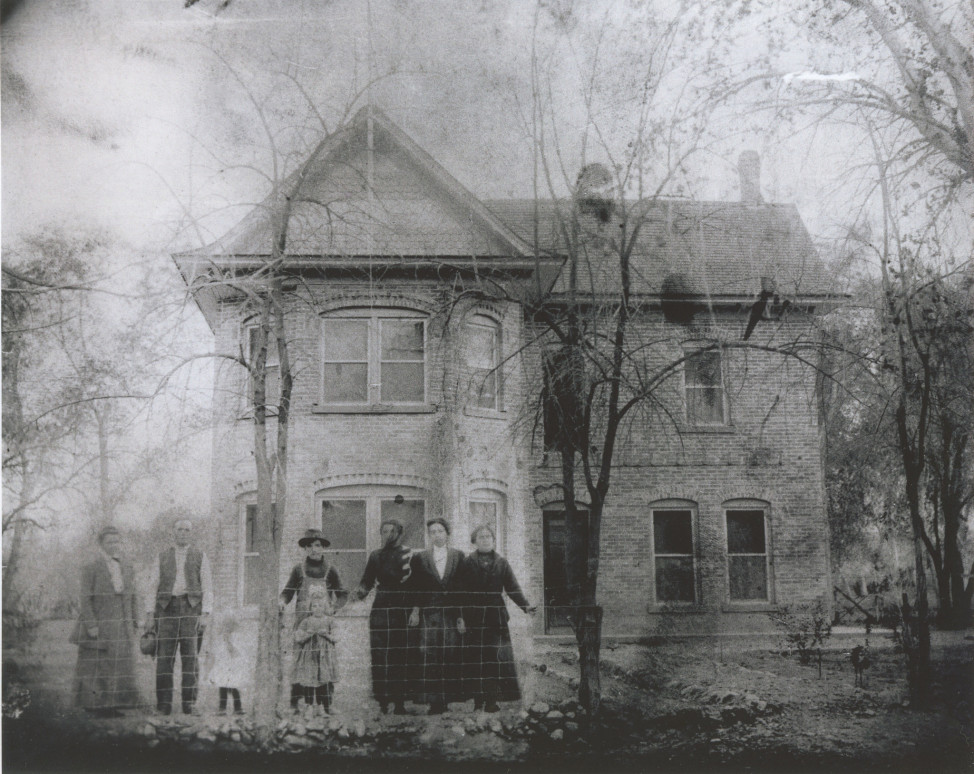
Group of people in front of Gentry Hotel in St. Thomas, Nevada. (Photo from the Gladys Gentry Collection via Lake Mead NRA Public Affairs via Flickr)
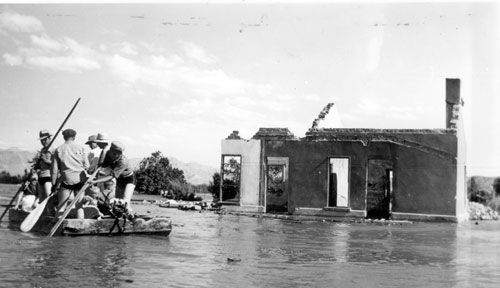
A salvage crew rafts through the town of St. Thomas near the ruins of a building as Lake Mead begins to submerge it in June 1938. (Photo: Lake Mead NRA Public Affairs via Flickr)
In 1928, President Calvin Coolidge signed the bill authorizing the building of what would become the Hoover Dam. St. Thomas residents were ordered to relocate and the U.S. government reimbursed them for their property. Residents abandoned the town as Lake Mead began to fill in 1935; the last resident to leave St. Thomas rowed away from his house in June of 1938.
When it is at capacity, Lake Mead is the largest man-made reservoir in the United States. At the lake’s highest point, St. Thomas was 60 feet below the water’s surface. But then came the fluctuation in water levels. Over the decades, drought conditions have given visitors repeated glimpses of the once-thriving wild west town and, since 2002, St. Thomas has remained exposed.
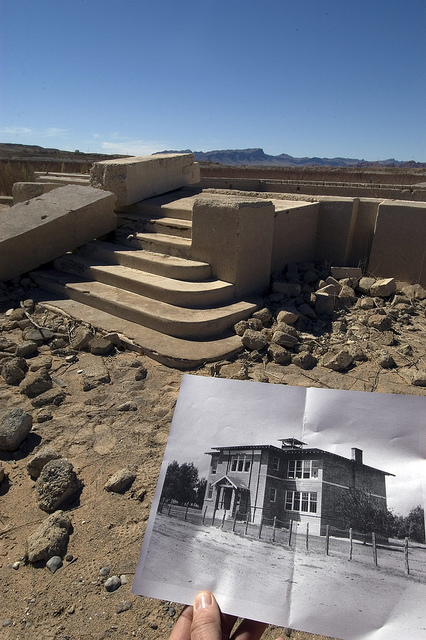
The foundation of the St. Thomas Schoolhouse, which once looked like the black and white photo, sat underwater for many years after Lake Mead filled. Due to declining water levels, the town resurfaced in 2002. (Photo: Lake Mead NRA Public Affairs via Flickr)
Today, you can still see the steps of the local schoolhouse and the wall of the St. Thomas ice cream parlor.
“It’s kind of ironic that this town was initially settled because of water…water was the source that started this town and then it was water that defeated the town when the lake filled up,” said Christie Vanover, public affairs officer for the Lake Mead National Recreation area. “And now it’s water that’s helped us to rediscover the town because of the drought and the lack of water.”
Visitors are free to wander around the area but are prohibited from touching or moving any objects long-ago residents left behind; those pieces are considered protected cultural artifacts.
“There are still artifacts on the ground in addition to the foundations,” said Vanover. “There’s also wheels, engines or other car parts that are still present from people who just abandoned their cars when they left the town.”
Federal officials expect St. Thomas to remain exposed for at least the next two years. However, Lake Mead, which gets its water supply from snow melt-off in the Colorado Rocky Mountains, could eventually refill, sending St. Thomas back to its underwater tomb.
“Which would be tragic for the town but would be very fortunate for our communities because we all definitely need more water in Lake Mead,” Vanover said.
Until then, from time to time, former residents and family members continue to hold reunions at St. Thomas, the last one being in 2012.
While they remember old times, the rest of the people who come to St. Thomas enjoy a unique — and possibly somewhat fleeting — chance to revisit history.
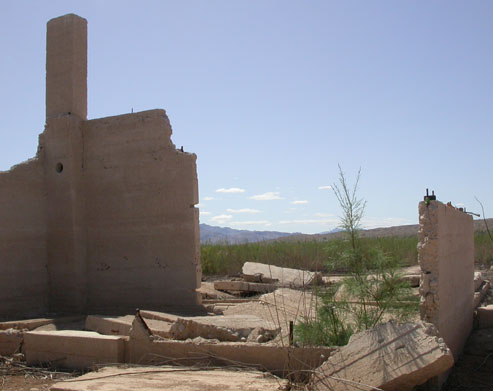
Building remains in St. Thomas, Nevada. (Photo by Flickr user Thure Johnson via Creative Commons license)




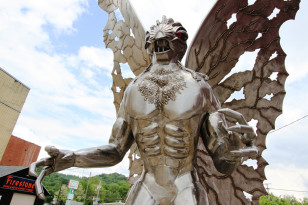
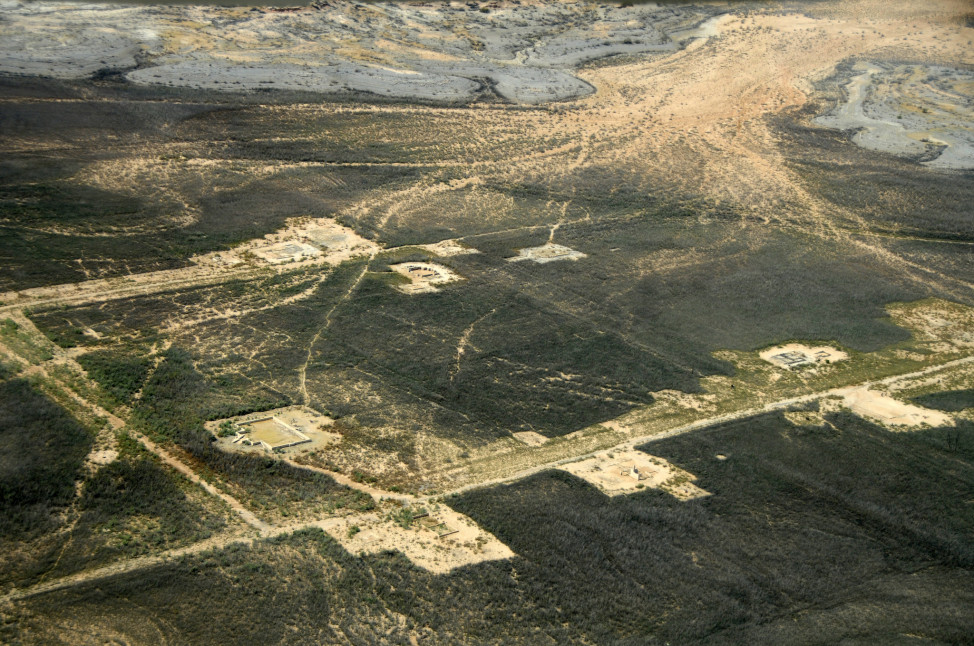
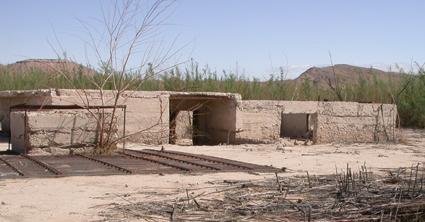





















Thank you for taking the time to share this story with us, Dora. I very much appreciate your writing style, and the way that you draw the reader in to care about ‘news’ aspect as much as the historical element. (I really liked the Burr vs Hamilton anniversary story last time!)
Articles like these are a big part of why I check in at V.O.A. on a daily basis.
Jake
Thank you for writing this article, it reflects historical fact for generations to come.
Love this. this is history at its core. Looking at the pics could not help to notice how good the steps were made at the school house. hope there are more pics that show the town as it really was. thank you.
Just keep building and wasting water in LasVegas who is running that city first graders our children wont be able to live there when they hit there 50s because there wont be any water WHY DO THEY CONTINUE TO BUILD when our they going to stop when there is no more water left unbelievable that is the crazy stupid thing they could do
Very cool. Thank you for doing the story on the St. Thomas town. This is the first time I have ever heard of St. Thomas town. I know it was not a big town but still it was home to all who had settled there.
Billy
The fact that this town was built when the area was not under water before any major manmade structures existed in the area suggests that the current drought conditions in the west is possibly a periodic phenomenon and not a manifestation of climate change. I’m not suggesting that climate change isn’t real but that the drought is not necessarily the result of it.
The drought in California and the rest of the west could have been mitigated, even prevented by much smarter government. I lived in California about 35 years ago when the population was 22 million. Even back then water was a major concern in the region. Now the population is 38 million. Had government invested say a billion or two a year on desalination plants it would now be operating a capital plant of 35 to 70 billion dollars of water production and distribution. California, were it a separate nation would have one of the top ten economies in the world. No one can say it could not have found the money to provide this vital necessity if it had been competently managed. Instead it diverted its resources to other places and much of it was money thrown away on useless projects.
The area wasn’t underwater way back then because it’s a man made lake, created by building a dam downstream on the Colorado River. Just saying, and no I don’t think “climate change” has anything to do with it. Meaning man caused climate change. Climates have been changing for millions of years, it’s nothing new even if ALGore gets rich claiming it is.
Climate change is an established fact. You should stop listening to Fox News and actually educate yourself. Scientists have never claimed that any particular weather event is a result of Climate Change but rather there is a world wide pattern. And the fact that you make a snide comment about Al Gore and the modest profits gotten from a documentary as opposed to the massive profits to the massive profits of the petro-chemical industry shows how foolish and misguided you are.
I was skeptical about climate change until I saw NASA’s photos photos over time of the polar ice caps and recent photos of the Columbia glacier in Prince William Sound, a place I’d been about 20 years earlier. When as much ice is melting as quickly as we’ve seen in the last few years it’s clear something big is happening.
That being said I’m still not convinced the cause is human activity, I’m undecided as there are other possible explanations. The proponents of mitigating measures did themselves and their cause no favors when they told a lot of lies. Unlike the argument for banning CFCs because they caused a hole in the ozone layer, the argument about climate change seemed largely political, not scientific. This first started in the 1990s when Europe could not compete against American industry and looked for any way to adversely impact the US economy. The Kyoto protocol voted down 95-0 in a sense of the Senate vote ended the Clinton administration’s participation in the talks. When American climatologists pointed out that Kyoto would only decrease average temperature by 2/3 of a degree over 65 years, the advocates then said Kyoto was just the beginning. Europe failed to live up to its Kyoto commitments and China and India said they would not sacrifice their economic growth for it, that the industrialized nations who enjoyed the benefits of creating climate change should be the only ones to pay the penalty. This at a time when China was starting up two new coal fired power plants a week. When China became the world’s largest CO2 producer and America’s CO2 “footprint” was declining, Europeans became very quiet about it.
The real nail in the coffin came when in 2009 just before the Copenhagen climate meeting it was revealed through hacked e-mail that scientists at East Anglia University had fudged their data and conclusions by splicing tree ring data to actual measurements over the prior fifty years because the tree ring data theory no longer was consistent with their pre-determined result. Neither did they point out that the number of measuring stations had decreased in rural areas over time and that data was increasingly coming from urban areas that were heat islands. Instead of offering an explanation they were simply outraged that they’d been hacked.
Without sacrifices by everyone including China, India, Brazil, the EU, Indonesia, there is no point in America making sacrifices as those efforts alone would be futile anyway. There has been an effort to reduce climate change by reducing meat consumption especially beef as the CO2 from raising cattle and methane, many times more powerful as a climate change agent than CO2 from bovine flatulence is also claimed as a factor. Is the WHO recent pronouncement that processed meat is a carcinogen and red meat is a suspected carcinogen part of a conspiracy? I don’t care, it will not deter me from one biteful of eating it.
amazeing thank you
The ancient Romans built a vast system of aqueducts to transport water from where it was plentiful to where it was needed. Examples of it can still be seen today thousands of years later. They had no power tools, no heavy machinery, no electricity, no way to blast the tops of mountains off or tunnel through them but they still managed to successfully engineer and build it. We could do the same today far more easily. We have many areas that are periodically inundated with water such as the Mississippi river which floods over nearly every year. Instead of building levees to contain it, it could be diverted to where it’s needed. There seems no federal program or long term strategy to manage water by relocating it from where it is a threat to places where it is lacking yet our Federal government has hundreds of billions for other projects and does not tax those who could afford to finance these projects. Small wonder so many of us are fed up with the people who rule Washington DC.
St. Thomas and neighboring town Kayoline were both buried by lake Mead and are both now exposed. They have been exposed for the past 15 years so this is old news. My family owns the range rights in the area and our cattle graze along the shores of lake Mead. I have had the opportunity to ride through these towns horseback on numerous occasions, it is very fascinating. The tall church steeple still stands and from the air it looks like a temple standing there in the middle of nowhere. The cisterns that they used for water storage at each home are still there and surprisingly not full of mud but full of water ready to use. These towns literally just picked up and walked away, town intact.
My ancestor lived in Kayoline for a time before moving to the Arizona Strip. The Mormon settlers trying to tame the muddy river failed four times before they where able to make it in this dry hard land. The Muddy Mission was extremely hard on them and trying to get the water out of the river and on to the land for irrigation was a lot of work, the heat was so hot, and of course there was no A/C, that in the beginning of this area it was almost imposable to produce enough to make a living. thus the mission failed four times. The settlers could not make it and would pack up and move out. latter the same or new settlers would come back and build upon what the previous left behind. Eventually they were able to stay for good.
Thank you, Mr. Bundy, for a most interesting first hand account! The history of our great and generous land is so important specially for the younger generations of Americans…
Thank you! Very well done!
I was skeptical about climate change for a long time. It seemed to me those who championed this cause had a political agenda. Many were Europeans targeting American industry and agriculture because they could not compete against it. The proponents did themselves no favor in 2009 when it was revealed that “researchers” in East Anglia University fudged their data. Rather than defend what they did they merely expressed outrage that their scheme had been uncovered by someone who hacked their e-mail. A short time later the Copenhagen meeting was a disastrous failure.
I changed my mind a few years ago when I saw photos taken from space of the polar ice caps. Also of the glaciers. In 1988 I was at the Columbia Glacier in Prince William Sound Alaska. More recent photos showed much of what I had seen had melted. When this much ice melts so quickly, something is happening. Whether it is manmade or not may still be open for debate but I’m convinced change is occurring. What can be done about it if anything is another matter. With China burning so much coal it seems anything the US might do to reduce its carbon dioxide emissions would be offset by China’s increases.
I think the EPA has very much overstepped its bounds by calling CO2 a pollutant. It is a natural constituent of the atmosphere. It is no more a pollutant than too much water in a place you don’t want it would be. That’s not to say it isn’t a problem but by not being a pollutant that probably puts it outside the control of EPA.
Thank you! I live in Las Vegas but I don’t go to Lake Mead because it’s too hot for me.But I had no idea it had dropped so low! I never hear anything about it on the local news! Thanks again!
its on the news quite often and in the RJ, etc etc.
pay attention pam
Thanks for a well written and documented article. We Americans need more like this about our history and how our people built our Nation.
Very cool article, I never no about it. One more story I lernd about Amerika .IAm sending it to Berlin Germany ,my hometown.Thank you.
Ulli.
Very interesting. Reminds me of the Three River Gouge Dam in China, I wonder What that lake looks like today?
I had been to Lake Mead in 1952 and Toured the Dam , Went boating and swimming in the Lake , And the next day flew over it . a GREAT experance.
Question? How far up river is this town?
Here’s a link that shows you a map of where St. Thomas is: http://www.nps.gov/lake/learn/nature/st-thomas-nevada.htm
My gg grandfather, Moses Gibson lived in St. Thomas. It was a hard life trying to farm that hot desert land. He died and was buried there. His son, my great grandfather died there as well. He was 19. His appendix burst and there was no doctor in town. He attempted to ride to St. George, Utah where the nearest doctor was and only made it two miles before he fell off his horse and died. He left behind a young wife and their baby, my grandfather. When Lake Mead reached the town, their graves were moved to Logandale Nevada.
Thank you for sharing the pictures of old St. Thomas. I lived in Overton, Nevada where some residents of St. Thomas moved when water covered St. Thomas. I was about 9 years old when Hover Dam began to drain Lake Mead. I heard that St. Thomas was now visible and the old residents in Overton planned a big reunion at St. Thomas for the 4th of July. So, I and a friend got on our horses to go as see St. Thomas. It looked much like the pictures you shared only the ground was covered with human bones and coffin handles. I Dad was a collector of Indian artifacts and even had a skeleton of an Indian in his collection. So when I saw the bones, I took two leg bones home with me for his collection. My friend, Delores and I mentioned the bones and coffin handles and the reunion committee went to take a look and reported it to the Clark County officials demanding that the human remains be reburied before the 4th of July. This did not happen and the water began to rise and soon the remains of old St. Thomas was no longer visible. My Dad is long dead, but I still have my bones. I guess not all the human remains made it to Logandale or Overton.
St.Thomas has been dry for 16 years and likely will remain so until the next cooling cycle of climate change. Which may be obscured by the lack of witnesses. We rant, rave and argue to no avail. Earth was past the point of no return before St Thomas emerged to live again.
Thank you love for your comments about the town of St Thomas. My grandmother taught at the school there while my grandfather was on a mission to Tonga.
She had very fond memories of that time.